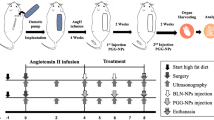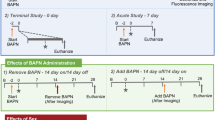Abstract
Treatment with doxycycline suppresses the development of abdominal aortic aneurysms (AAAs) in experimental animal models, but its use in humans can be accompanied by dose-related side effects. We sought to determine if localized administration of doxycycline can achieve inhibition of AAAs equivalent to that achieved by systemic treatment. C57BL/6 mice underwent transient elastase perfusion of the abdominal aorta to induce the development of AAAs. After 14 days, the mean increase in aortic diameter was reduced from 167.2 ± 7.8% in untreated mice to only 129.7 ± 13.8% in mice treated with 100 mg/kg/day oral doxycycline (p < 0.05). Using osmotic minipumps to provide continuous periaortic infusion of doxycycline, localized infusion at rates of 0.75 to 1.0 mg/kg/day suppressed AAAs to an equivalent or even greater extent than systemic treatment [mean increase in aortic diameter 131.5 ± 14.4% at 0.75 mg/kg/day, p < 0.05; 103.2 ± 13.5% at 1.0 mg/kg/day, p < 0.01). Mean plasma doxycycline levels reached 332 ± 62 ng/mL during oral administration, but the drug was undetectable in the circulation during localized infusion. The doxycycline concentration in aortic tissue extracts was 22 ± 6 ng/mL during systemic treatment compared to only 5.6 ± 2.2 ng/mL [at 0.75 mg/kg/day] and 7.8 ± 4.0 ng/mL [at 1.0 mg/kg/day] during localized infusion (p < 0.05). Localized administration of doxycycline can effectively suppress experimental AAAs with undetectable plasma drug levels, even at doses 100-fold lower than those used during oral drug administration. Localized delivery of doxycycline holds promise as a novel strategy to inhibit the progressive expansion of aortic aneurysms, perhaps as a pharmacological adjunct to endovascular (stent graft) treatment.




Similar content being viewed by others
References
UK Small Aneurysm Trial Participants. Mortality results for randomised controlled trial of early elective surgery or ultrasonographic surveillance for small abdominal aortic aneurysms. Lancet 1998;352:1649–1655
Lederle FA, Wilson SE, Johnson GR, et al. Immediate repair compared with surveillance of small abdominal aortic aneurysms. N Engl J Med 2002;346:1437–1444
Powell JT, Brady AR. Detection, management, and prospects for the medical treatment of small abdominal aortic aneurysms. Arterioscler Thromb Vasc Biol 2004;24:241–245
Koch AE, Haines GK, Rizzo RJ, et al. Human abdominal aortic aneurysms. Immunophenotypic analysis suggesting an immune-mediated response. Am J Pathol 1990;137:1199–1213
Freestone T, Turner RJ, Coady A, Higman DJ, Greenhalgh RM, Powell JT. Inflammation and matrix metalloproteinases in the enlarging abdominal aortic aneurysm. Arterioscler Thromb Vasc Biol 1995;15:1145–1151
Pyo R, Lee JK, Shipley JM, et al. Targeted gene disruption of matrix metalloproteinase-9 (gelatinase B) suppresses development of experimental abdominal aortic aneurysms. J Clin Invest 2000;105:1641–1649
Longo GM, Xiong W, Greiner TC, Zhao Y, Fiotti N, Baxter BT. Matrix metalloproteinases 2 and 9 work in concert to produce aortic aneurysms. J Clin Invest 2002;110:625–632
Thompson RW, Baxter BT. MMP inhibition in abdominal aortic aneurysms: rationale for a prospective randomized clinical trial. Ann NY Acad Sci 1999;878:159–178
Golub LM, Lee HM, Ryan ME, Giannobile WV, Payne J, Sorsa T. Tetracyclines inhibit connective tissue breakdown by multiple non-antimicrobial mechanisms. Adv Dent Res 1998;12:12–26
Petrinec D, Liao S, Holmes DR, Reilly JM, Parks WC, Thompson RW. Doxycycline inhibition of aneurysmal degeneration in an elastase-induced rat model of abdominal aortic aneurysm: preservation of aortic elastin associated with suppressed production of 92 kD gelatinase. J Vasc Surg 1996;23:336–346
Prall AK, Longo GM, Mayhan WG, et al. Doxycycline in patients with abdominal aortic aneurysms and in mice: comparison of serum levels and effect on aneurysm growth in mice. J Vasc Surg 2002;35:923–929
Kaito K, Urayama H, Watanabe G. Doxycycline treatment in a model of early abdominal aortic aneurysm. Surg Today 2003;33:426–433
Manning MW, Cassis LA, Daugherty A. Differential effects of doxycycline, a broad-spectrum matrix metalloproteinase inhibitor, on angiotensin II-induced atherosclerosis and abdominal aortic aneurysms. Arterioscler. Thromb Vasc Biol 2003;23:483–488
Curci JA, Mao D, Bohner DG, et al. Preoperative treatment with doxycycline reduces aortic wall expression and activation of matrix metalloproteinases in patients with abdominal aortic aneurysms. J Vasc Surg 2000;31:325–342
Baxter BT, Pearce WH, Waltke EA, et al. Prolonged administration of doxycycline in patients with small asymptomatic abdominal aortic aneurysms: report of a prospective (phase II) multicenter study. J Vasc Surg 2002;36:1–12
Mosorin M, Juvonen J, Biancari F, et al. Use of doxycycline to decrease the growth rate of abdominal aortic aneurysms: a randomized, double-blind, placebo-controlled pilot study. J Vasc Surg 2001;34:606–610
Steinmetz EF, Buckley C, Shames ML, et al. Treatment with simvastatin suppresses the development of experimental abdominal aortic aneurysms in normal and hypercholesterolemic mice. Ann Surg 2005;241:92–101
Sho E, Chu J, Sho M, et al. Continuous periaortic infusion improves doxycycline efficacy in experimental aortic aneurysms. J Vasc Surg 2004;39:1312–1321
Franklin IJ, Harley SL, Greenhalgh RM, Powell JT. Uptake of tetracycline by aortic aneurysm wall and its effect on inflammation and proteolysis. Br J Surg 1999;86:771–775
Author information
Authors and Affiliations
Corresponding author
Additional information
Portions of this work were initially presented at the Lifeline Foundation Research Forum of the Society for Vacular Surgery, June 3-6, 2004, Anaheim, CA.
About this article
Cite this article
Bartoli, M.A., Parodi, F.E., Chu, J. et al. Localized Administration of Doxycycline Suppresses Aortic Dilatation in an Experimental Mouse Model of Abdominal Aortic Aneurysm. Ann Vasc Surg 20, 228–236 (2006). https://doi.org/10.1007/s10016-006-9017-z
Received:
Revised:
Accepted:
Published:
Issue Date:
DOI: https://doi.org/10.1007/s10016-006-9017-z




